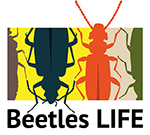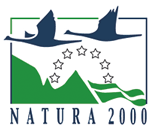Measures in the Beetles LIFE Project
The aim of the Beetles LIFE project is to improve the protection of the endangered target species. Why amid the debate on climate change and the major environmental issues should attention be given to small invertebrates? Why should these species be protected?
Because of their status in their living environment. They are indicator species: they symbolise biodiversity in forests and the state of nature. Protecting indicator species means at the same time ensuring a broad diversity of other species. The restoration work done in the project will therefore help countless other species, especially those which favour sunny environments and rotting timber.
Restoration measures
While the project is under way a number of things will be accomplished. There will be more areas of conservation for species, restoration of wooded bogland, increased amounts of decayed timber, a more reliable supply of aspen for the target species and a good deal of restoration burning. A new, private nature reserve covering 40 hectares is to be established in Harjula. Around 290 hectares of wooded bogland on various Natura 2000 sites will be restored, there will be an additional 100 hectares of rotten timber available and 120 hectares of aspen growth will be promoted.
Restoration work is necessary for species, as it helps to establish forest the like of which is hardly possible with current forestry methods. Fallen, rotten wood left in the wild, the changes to forests caused by fires, and trees left to dry out are examples of the best possible habitats and feeding grounds of the target species.
The main type of restoration work done during the project is forest restoration burning, which is carried out in 16 different places over an area of almost 350 hectares. Most restoration burning takes place in Urho Kekkonen National Park, where 206 hectares of forest is being restored in this way.
Despite restoration, an environment suitable enough for the beetles that are the focus of this project will not come into being very quickly: the work done will only help the species concerned after a certain amount of time has passed.
Telling the story
The project’s aim is to raise awareness of the target species and the issue of biodiversity and get people to think again about what the flagship species are when it comes to nature conservation.
The target species are so interesting that they deserve a new approach to project communications. We are trying to make the tiny huge, for nature to benefit as much as possible. We combine visual imagery, product design, functionality and science in our communications, to get the message across. We bring endangered wildlife closer to the public by planning and putting on events for young people and families.
The project entails widespread collaboration with artists and scientists. The goal too is to reach those whom conventional messages regarding nature conservation just do not reach.
Songs and lyrics
Biisisanoittamo was a song lyrics writing contest organised by Humak Humanistinen ammattikorkeakoulu. Topic of the contest was endangered nature. Winning lyrics named Kuudes aalto would be built to a complete song by professional musicians, arranged and published in Spotify. This video is a premiere of Kuudes aalto, the winner, in Nuuksio national park in september 2020.
Last updated 26 October 2020


